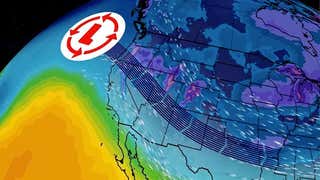

US
°C





Last year was Earth's third-warmest year on record.The planet experienced record-high rises in sea levels in 2017.Glaciers across the world lost mass for the 38th consecutive year on record.
Earth-warming greenhouse gases released into theatmosphere in 2017 reached the highest level in 800,000 years, according to the report released Wednesday.
The international report with contributions from more than 500 scientists worldwide is led by the National Oceanic and Atmospheric Administration. Itexamines temperature, precipitation and weather events throughout the world in 2017.
"[This report] is like a doctor's checkup," said Jeff Rosenfeld, editor-in-chief of the Bulletin of the American Meteorological Society, during a press conference call. "It tests the same things year in and year out. Those baselines help us to detect change and figure out what's normal and what's not over the long run."
According to the 300-page report,the annual global average carbon dioxide concentration at Earth’s surface for 2017 was 405.0 ppm, which is 2.2 ppm greater than in 2016 and the "highest in the modern atmospheric measurement record and in ice core records dating back as far as 800,000 years."
The report noted that levels of CO2 have quadrupled since the early 1960s.
Sea levels hit a new high. Seas are rising an average rate of 1.2 inches a decade, the report said. The world's seas are now about 3 inches higher than in 1993.
A polar bear on an island of the Frantz Josef Land archipelago.
(Vera Kostamo/Sputnik via AP)
Depending on two different datasets since the 1880s, 2017 also ranked either the second or third warmest years on record and the warmest non-El Niño year on record. The four warmest years on record are 2014, 2015, 2016 and 2017.
Argentina, Uruguay, Spain, and Bulgaria all reported record high annual temperatures, while Mexico broke its annual record for the fourth year in a row.
Pakistan recorded its all-time highest temperature of 128.3 degrees Fahrenheit (53.5 degrees Celsius) on May 28, 2017, in Turbat. It also becamethe world-record highest temperature for the month of May.
The Arctic experienced its second highestland surface temperature of 1.6 degrees Celsius abovethe 1981-2010 average in 2017, coming just behind 2016. The report notes the five highest land surface temperatures recorded in the Arctic since 1900 have occurredsince 2007.
"According to paleoclimate studies, today’s abnormally warm Arctic air and SSTs have not been observed in the last 2,000 years," the report noted. The warm temperatures have led to a decrease in Arctic sea ice extent, which covered 8 percent less area than the 1981-2010 average in 2017.
Glaciers across the world lost mass for the 38th consecutive year on record.
"Cumulatively since 1980, this loss is equivalent to slicing 22 meters (72 feet) off the top of the average glacier," the report says.
The average sea surface temperaturecooled a bit since 2016 but was still among the three highest annual values observed.
The March 2017 sea ice maximum was the lowest on record. Ten of the lowest September minimum extents have occurred in the last 11 years.
Emily Osborne, program manager for NOAA’s Arctic Research Program, noted during the media conference call that "paleoclimate records show that the magnitude and sustained rate of sea ice loss are unprecedented in the last 1,450 years."
The report also noted the exceptional hurricane season in 2017, which was the most active since 2005 in the Atlanticand included hurricanes Harvey, Irma and Maria. Of note was the record-breaking rainfall over parts of Texas during Harvey, with totals that topped 60 inches in some areas.
Irma was the strongest tropical stormin 2017 and the strongest Atlantic hurricane outside of the Gulf of Mexico and Caribbean on record.
Maria was noted for the catastrophic destructionacross the Caribbean Islands, including devastating wind damage and flooding across Puerto Rico.
TheU.S.experienced 16 disasters with loses of more than $1 billion, including the three hurricanes. These disasters resulted in more than $300 billion in direct losses in 2017, making it the costliest year since at least 1980 for total losses from billion-dollar disasters.
Precipitationin 2017 was also heavy in parts of Russia, which reported its secondwettest year on record, and Norway, which marked its sixth wettest year.
"Precipitation over global land areas in 2017 was clearly above the long-term average," the report noted. "Across India, heavy rain and flood-related incidents during the monsoon season claimed around 800 lives."
Drought conditions were experienced throughout the world. At least 3 percent of the world'sland area was affected by extreme drought conditions in each month of 2017.
In Canada's British Columbia, extreme drought led to the province's most extensive wildfire season on record.
A three-year coral bleaching event, which lasted from June 2014 to May 2017, was the "longest, most widespread, and almost certainly most destructive such event on record," the report noted.
Despite the bad news, there were a few positive highlights in the report, as well.
The year was marked by the second smallest Antarctic ozone hole observed since 1988.
Global fire activity was its lowest since 2003. However,high activity occurred in parts of North America, South America, and Europe.
In the United States, an extreme western wildfire season burned more than15,450 square miles at atotal costof $18 billion, whichtripled the previous U.S. annual wildfire cost record set in 1991.












